 |
 |
 |
| |
A RETROSPECTIVE ANALYSIS OF BONE LOSS IN
EMTRICITABINE/TENOFOVIR THERAPY FOR HIV PrEP
|
| |
| |
CROI 2022 Feb 11-16
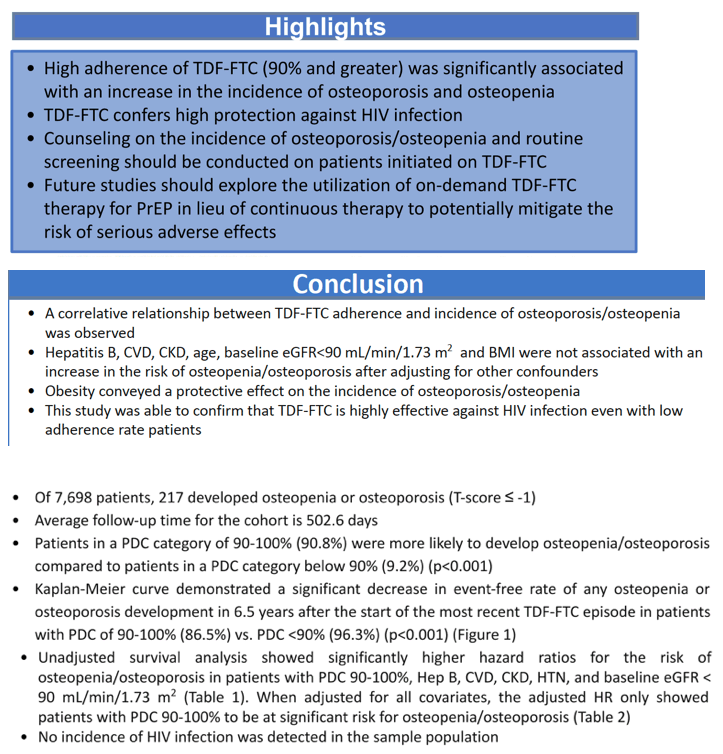
Joseph C. Chang1, Duy Do2, Hector M. Delgado3, An Huynh4
1Kaiser Permanente Medical Center, Los Angeles, California, USA, 2Kaiser Permanente Southern California, Pasadena, CA, United States, 3Kaiser Permanente Medical Center, Los Angeles, CA, USA, 4Kaiser Permanente, Los Angeles, CA 90038, USA
Background:
FTC-TDF is FDA approved for the treatment of HIV infection and PrEP. It is known to cause bone loss in about 1-3% of HIV treated patients. However, a large meta-analysis on TDF in 2020 did not yield a significant bone loss result in PrEP patients. Long-term large randomized or retrospective studies address bone loss in FTC-TDF therapy for PrEP are also limited. Hence, this study aims to address the risk of osteopenia in a real life setting for patients on FTC-TDF for PrEP.
Methods:
In this retrospective study, patients on FTC-TDF for PrEP from 2012-2020 without any prior history of bone loss in the Southern California region (N=7,698) were studied for the following criteria: bone density during follow-up, medication adherence, age, sex, race, history of HepB/HepC/DM CVD/CKD/HTN, eGFR, and BMI. Data was extracted from the Kaiser Permanente HealthConnect System. Adherence was defined using the proportion of days covered (PDC) ratio. Patients were divided into groups based on their follow-up bone density, T-score ≤ -1 (osteopenia and osteoporosis) vs. > -1 (normal). Descriptive statistics was used to compare patient characteristics between these two groups. A Cox proportion proportional hazards model was used to estimate the relationship between patient characteristics and bone loss for up to 7 years following their most recent PrEP episode.
Results:
3% (217/7,698) were found to have osteopenia after the start of therapy.
High compliance rate, white race, Hep B, DM, CVD, CKD, HTN, and baseline eGFR<90 had a higher rate of osteopenia.
Significantly higher rate of bone loss was also observed in patients with higher PDC ratio, PDC 90-100% (90.8%) vs. PDC <90% (9.2%).
Kaplan-Meier curve showed event-free rate of osteopenia decreased with time (89.4% In 6.5yrs); PDC 90-100% group had greater reduction of event free rate (86.5 vs 96.3% in 6.5 yrs).
Survival analysis showed statistically significant hazard ratio (HR) in patients with PDC 90-100%, Hep B, CVD, CKD, HTN, and baseline eGFR<90. However, when adjusted for all variables, the adjusted HR only showed patients with PDC 90-100% to be at significant risk for osteopenia (5.36 [3.34, 8.61]).
Conclusion:
Our cohort showed a similar rate of osteopenia compared to HIV patients. Event-free rate is inversely proportional with time and intensity of exposure. High compliance rate and prolonged exposure may have higher risk of developing osteopenia. Hence routine check-up for osteopenia may be needed for these two groups of patients.

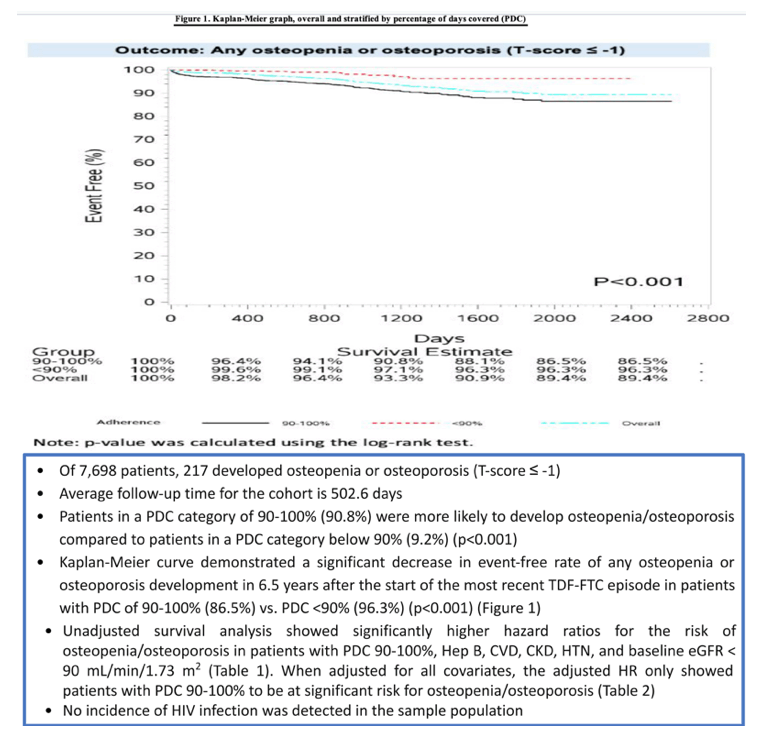
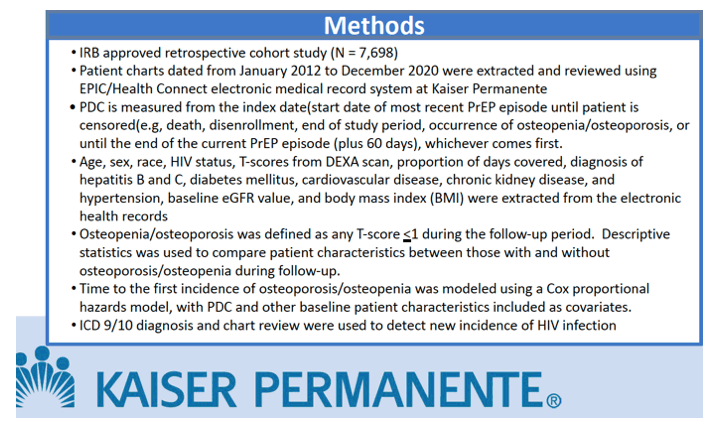

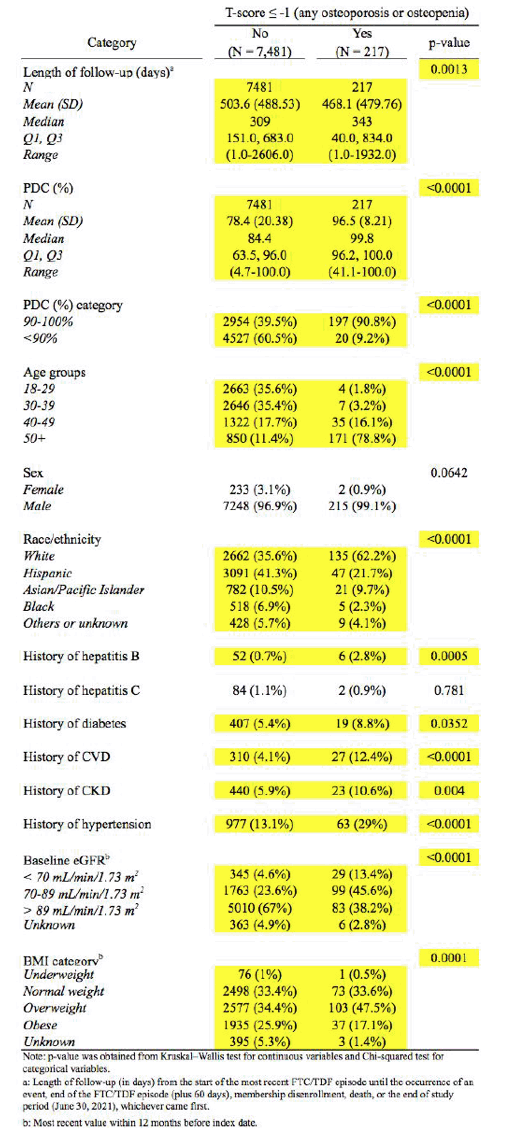

References
1. McCormack S, Dunn DT, Desai M, et al. Pre-exposure prophylaxis to prevent the acquisition of HIV-1 infection (PROUD): effectiveness results from the pilot phase of a pragmatic open-label randomised trial. Lancet. 2016;387:53-60.
2. Grinsztejn B, Hoagland B, Moreira RI, et al. Retention, engagement, and adherence to pre-exposure prophylaxis for men who have sex with men and transgender women in Brasil: 48 week results of a demonstration study. Lancet HIV. 2018;5:e136-46.
3. Baeten JM, Donnell D, Ndase P, et al. Antiretroviral Prophylaxis for HIV-1 Prevention among Heterosexual Men and Women. N Engl J Med. 2012:367(5):399-410.
4. Molina JM, Capitant C, Spire B, et al. On-Demand Preexposure Prophylaxis in Men at High Risk for HIV-1 Infection List of authors. N Engl J Med. 2015;373:2237-2246.
5. Desai M, Field N, Grant R, McCormack S. Recent advances in pre-exposure prophylaxis for HIV. BMJ. 2017;359:j5011. Published 2017 Dec 11. doi:10.1136/bmj.j5011
6. Emtricitabine/Tenofovir Disoproxil Fumarate. Micromedex. Accessed October 10, 2021.
7. Emtricitabine/Tenofovir Disoproxil Fumarate. Lexicomp. Accessed October 10, 2021.
8. Baranek B, Wang S, Cheung AM, Mishra S, Tan DH. The effect of tenofovir disoproxil fumarate on bone mineral density: a systematic review and meta-analysis. Antivir Ther. 2020;25(1):21-32. doi: 10.3851/IMP3346. PMID: 32077867.
9. Haskelberg H, Hoy JF, Amin J, Ebeling PR, Emery S, Carr A, et al. (2012) Changes in Bone Turnover and Bone Loss in HIV-Infected Patients Changing Treatment to Tenofovir-Emtricitabine or Abacavir-Lamivudine. PLoS ONE 7(6): e38377.
https://doi.org/10.1371/journal.pone.0038377 Grace A. McComsey, Douglas Kitch, Eric S. Daar, Camlin Tierney, Nasreen C. Jahed, Pablo Tebas, Laurie Myers, Kathleen Melbourne, Belinda Ha, Paul E. Sax, Bone Mineral Density and Fractures in Antiretroviral-Naive Persons Randomized to Receive Abacavir-Lamivudine or Tenofovir Disoproxil Fumarate-Emtricitabine Along With Efavirenz or Atazanavir-Ritonavir: AIDS Clinical Trials Group A5224s, a Substudy of ACTG A5202, The Journal of Infectious Diseases, Volume 203, Issue 12, 15 June 2011, Pages 1791–1801
https://doi.org/10.1093/infdis/jir188
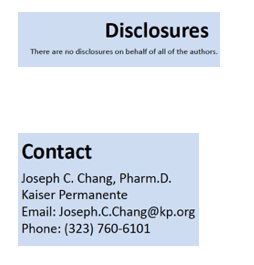
|
| |
|
 |
 |
|
|